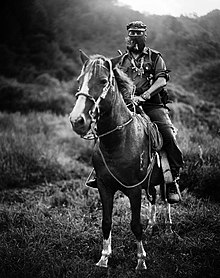
Back ماركوس Arabic ماركوس (فيلسوف من الميكسيك) ARZ Subcomandante Marcos AST Субкамандантэ Маркас Byelorussian Subcomandant Marcos Catalan Subcomandante Marcos Czech Subcomandante Marcos German Σουμπκομαντάντε Μάρκος Greek Subcomandante Marcos Spanish Subcomandante Marcos Estonian
Subcomandante Marcos | |
|---|---|
 Marcos, smoking a pipe atop a horse in Chiapas, Mexico in 1996. | |
| Born | 19 June 1957 Tampico, Tamaulipas, Mexico |
| Other names |
|
| Education | Instituto Cultural Tampico |
| Alma mater | National Autonomous University of Mexico (BA, MA) |
| Occupations | |
| Movement | Neozapatismo |
| Military career | |
| Allegiance | |
| Service | |
| Years of service | 1994–2014 |
| Rank | Capitán Subcommander (formerly) |
| Battles / wars | Chiapas conflict • Zapatista uprising |
| Website | Official website |
Rafael Sebastián Guillén Vicente (born 19 June 1957)[1] is a Mexican insurgent, the former military leader and spokesman for the Zapatista Army of National Liberation (EZLN) in the ongoing Chiapas conflict,[2] and a prominent anti-capitalist and anti-neoliberal.[3] Widely known by his initial nom de guerre Subcomandante Insurgente Marcos (frequently shortened to simply Subcomandante Marcos), he has subsequently employed several other pseudonyms: he called himself Delegate Zero during the Other Campaign (2006–2007), Subcomandante Insurgente Galeano (again, frequently with the "Insurgente" omitted) from May 2014 to October 2023, which he adopted in honor of his fallen comrade Jose Luis Solis Lopez, his nom de guerre being Galeano, aka "Teacher Galeano".[4] and since October 2023, Capitán Insurgente Marcos.[5] Marcos bears the title and rank of Capitán (or "Captain in English), and before that Subcommandante, (or "Subcommander" in English), as opposed to Comandante (or "Commander" in English), because he is under the command of the indigenous commanders who constitute the EZLN's Clandestine Revolutionary Indigenous Committee's General Command (CCRI-CG in Spanish).
Born in Tampico, Tamaulipas, Marcos earned a degree from the Faculty of Philosophy and Literature at the prestigious National Autonomous University of Mexico (UNAM),[6] and taught at the Autonomous Metropolitan University (UAM) for several years during the early 1980s.[1] During this time he became increasingly involved with a guerrilla group known as the National Liberation Forces (FLN), before leaving the university and moving to Chiapas in 1984.[1]
The Ejército Zapatista de Liberación Nacional (EZLN) (Zapatista Army of National Liberation; often simply called the Zapatistas) was the local Chiapas wing of FLN, founded in the Lacandon Jungle in 1983, initially functioning as a self-defense unit dedicated to protecting Chiapas' Mayan people from evictions and encroachment on their land. While not Mayan himself, Marcos emerged as the group's military leader, and when the EZLN, acting independently of the FLN, began its rebellion on 1 January 1994, he served as its spokesman.[2]
Known for his trademark ski mask and pipe and for his charismatic personality, Marcos coordinated the EZLN's 1994 uprising, headed up the subsequent peace negotiations, and played a prominent role throughout the Zapatistas' struggle in the following decades. After the ceasefire the government declared on day 12 of the revolt, the Zapatistas transitioned from revolutionary guerrillas to an armed social movement, with Marcos's role transitioning from military strategist to public relations strategist. He became the Zapatistas' spokesperson and interface with the public, penning communiqués, holding press conferences, hosting gatherings, granting interviews, delivering speeches, devising plebiscites, organizing marches, orchestrating campaigns, and twice touring Mexico, all to attract national and international media attention and public support for the Zapatistas.[7]
In 2001, he headed a delegation of Zapatista commanders to Mexico City to deliver their message on promoting indigenous rights before the Mexican Congress, attracting widespread public and media attention. In 2006, Marcos made another public tour of Mexico, which was known as The Other Campaign. In May 2014, Marcos stated that the persona of Subcomandante Marcos had been "a hologram" and no longer existed.[8] Many media outlets interpreted the message as Marcos retiring as the Zapatistas' military leader and spokesman.[9]
Marcos is a prolific writer whose considerable literary talents have been widely acknowledged by prominent writers and intellectuals,[10] with hundreds of communiqués and several books being attributed to him. Most of his writings are anti-capitalist while advocating for indigenous people's rights, but he has also written poetry, children's stories, and folktales and co-authored a crime novel.[10] He has been hailed by Régis Debray as "the best Latin American writer today". Published translations of his writings exist in at least 14 languages.[11]
- ^ a b c Henck 2007, p. 11.
- ^ a b Pasztor, S. B. (2004). Marcos, Subcomandante. In D. Coerver, S. Pasztor & R. Buffington, Mexico: An encyclopedia of contemporary culture and history. Santa Barbara, CA: ABC-CLIO
- ^ Henck 2019, p. 19.
- ^ Roitman Rosenmann, Marcos (25 May 2014). "El asesinato de José Luis Solís López, Galeano". La Jornada (in Spanish). Archived from the original on 17 January 2019. Retrieved 16 February 2019.
- ^ Cid, Alejandro Santos (3 January 2024). "The silence of Captain Marcos". EL PAÍS English. Retrieved 11 November 2024.
- ^ Henck 2007, pp. 29–37.
- ^ Henck 2019, pp. 26–27.
- ^ A four-part video, complete with English subtitles, of the Subcommander's final public appearance as Marcos, prior to transforming into Galeano, in which he made this statement, can be found at: 1-Between light and shadow. Sup Marcos' last public speech. English subtitles – YouTube Archived 1 February 2021 at the Wayback Machine; 2-Between light and shadow. Sup Marcos' last public speech. English subtitles – YouTube Archived 5 February 2022 at the Wayback Machine; 3-Between light and shadow. Sup Marcos' last public speech. English subtitles Archived 27 January 2022 at the Wayback Machine; and 4-Between light and shadow. Sup Marcos' last public speech. English subtitles Archived 5 February 2022 at the Wayback Machine,
- ^ Althaus, Dudley (27 May 2014). "Mexican Rebel Leader Subcomandante Marcos Retires, Changes Name". Wall Street Journal. Archived from the original on 3 October 2016.
- ^ a b Henck 2019, pp. 44–45.
- ^ See Subcomandante Marcos bibliography